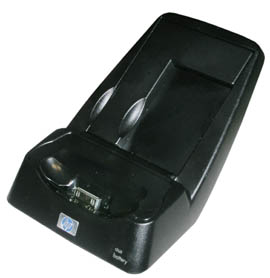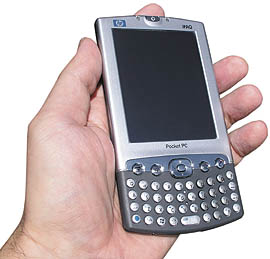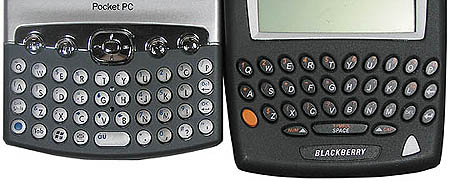The HP iPAQ 4000 Series
Two new iPAQs, including the first Pocket PC with a keyboard
(Pen Computing Magazine, November 2003 issue) --
No one can accuse Hewlett Packard of resting on its laurels as the world's Pocket PC top dog. During a difficult time in HP's corporate life where everyone was busy merging Compaq's very different culture into HP, whoever is responsible for the iPAQ brand did an extra-terrific job at it. Not only did the iPAQ part of the Compaq/HP transition go smooth as can be, but us lucky consumers are bombarded with one new iPAQ after another, each new one more spectacular than the last. So just as we were done marveling over the two significantly upgraded 1900 Series models, HP called with more news: "The 4000 Series is ready. Do you want to take an early peek?" Did we ever!

So the new iPAQ h4150 and h4350 arrived and had us drop everything else for a few days. As can be seen in the pictures above, at first sight they do not appear to belong to the same family. Well, the top does, but not the bottom. The h4150 looks like a high end 1900 Series model whereas the h4350, the first ever iPAQ with an integrated keyboard, seems a different device altogether. This is not like Handspring which once built the original Treo 180 both in a keyboard and a non-keyboard version, but they were both essentially the same device. These two terrific new iPAQs are very different from one another and will appeal to different customers. They do, however, share a lot of technology, so let's start there:
Like most new Pocket PCs, the 4000 Series models are built around the 400MHz version of Intel's XScale PXA255 processor. Both have 64MB of SDRAM and 32MB of ROM. 128MB would have been nicer, but these are, after all, not HP's top of the line iPAQs. Anyway, of the 64MB, about 57MB is available to the user, and between three and seven is reserved for non-volatile internal backup. Both have impressive transflective TFT displays measuring 3.5 inches diagonal. Both have removable Li-Ion battery packs. Both have, YEAH!, built-in Bluetooth and built-in 802.11b wireless LAN. Both have "real" 3.5 mm earphone jacks, not those tiny 2.5 mm ones that require an adapter.  Both come with a nicely designed new cradle and a basic protective canvas slip cover. Both use HP's favorite power plug arrangement: The power cable jacks into the included cradle, but the devices themselves have no separate power plug (see pic of 4150 above). To charge them away from the cradle, you need to use the included adapter which feeds power through the cradle connector. The adapter is attached to the power cord with a rubber link. This will never be my favorite design, but that's how HP does it these days. The cradle, on the other hand, is an elegant matte-black plastic affair with a place to charge a spare battery. The 4000 Series shares the same basic design, though the different size batteries and housings require plastic inserts in the 4150's cradle (see image).  Unlike most cradles which have a USB cable attached to them, these cradles have a 4-pin USB jack and a separate USB cable. This way the cradle can just sit on your desk without having that long USB cable attached to it when you don't need it. Loose cables often get lost, but at least this one is an easily-replaced standard part. Both new iPAQs, of course, come with Windows Mobile 2003 for Pocket PC, that stalwart platform with its ubiquitous suite of very useful Pocket applications. The latest version sits on top of the very stable and powerful rev. 4.2 of Windows CE .Net, but the look remains the same. This interface has been around for so long and I have gotten so used to it, it seems like simplicity itself compared to those ever more complex and non-standard Palm OS interfaces. Quite ironic given that Pocket PCs were once considered complicated and Palms simple. Unlike most cradles which have a USB cable attached to them, these cradles have a 4-pin USB jack and a separate USB cable. This way the cradle can just sit on your desk without having that long USB cable attached to it when you don't need it. Loose cables often get lost, but at least this one is an easily-replaced standard part. Both new iPAQs, of course, come with Windows Mobile 2003 for Pocket PC, that stalwart platform with its ubiquitous suite of very useful Pocket applications. The latest version sits on top of the very stable and powerful rev. 4.2 of Windows CE .Net, but the look remains the same. This interface has been around for so long and I have gotten so used to it, it seems like simplicity itself compared to those ever more complex and non-standard Palm OS interfaces. Quite ironic given that Pocket PCs were once considered complicated and Palms simple.
Now that we've looked at the similarities between the two new iPAQs, what
sets these wonderful new devices apart?
iPAQ 4150: The Mini Cooper S of Pocket PCs
 Let's take the more conventional 4150 first. Mini Cooper? Yes, another automotive analogy. This iPAQ is the Mini Cooper S of Pocket PCs. The Mini Cooper, of course, is the lovable little showbox on wheels that's both terminally cute and a serious performer. The "S" model is the hot version, the one with the super charger. Same with the 4150. It looks like the innocent little 1900 Series iPAQs that represent HP at the entry level where they valiantly duke it out with a gaggle of lesser Palms and Sonys. Even techno geeks might easily mistake the 4150 for one of those fine starter PDAs. And truth be told, looking at the new model you'd never guess what HP managed to pack into this little beauty. Let's take the more conventional 4150 first. Mini Cooper? Yes, another automotive analogy. This iPAQ is the Mini Cooper S of Pocket PCs. The Mini Cooper, of course, is the lovable little showbox on wheels that's both terminally cute and a serious performer. The "S" model is the hot version, the one with the super charger. Same with the 4150. It looks like the innocent little 1900 Series iPAQs that represent HP at the entry level where they valiantly duke it out with a gaggle of lesser Palms and Sonys. Even techno geeks might easily mistake the 4150 for one of those fine starter PDAs. And truth be told, looking at the new model you'd never guess what HP managed to pack into this little beauty.
But appearance deceives. Although at first sight the 4150 with its 2.8 by 4.5 inch footprint looks like a 1900 Series iPAQ, it's really a completely different design. It is almost as thin and light as the h1930/40 but not quite (though almost no one will be able to tell the small difference). It weighs just under five ounces, perhaps 0.4 ounces more than a 1900 Series. However, that less than half an ounce of extra weight was put to extremely good use. While we laud HP's decision to explore a new CPU design in the new entry level models, the 400 MHz PXA chip mounted in the engine bay of the 4150 is clearly faster than the Samsung processor in the 1900 Series. There's no substitute for cubic inches, or processor cycles in this case. And having built-in 802.11b wireless LAN is simply priceless as it leaves the SD Card slot available and you never have to hassle with settings or peripherals. With more and more places having wireless LAN and "hotspots," having wireless capability built right into the device is a tremendous convenience.
The 3.5-inch frontlit transmissive display, I must admit, is a bit of a mixed blessing. Compared to the Sony LCD used in the 4350, it has a distinct and noticeable yellowish tint. It doesn't impact readability, but it's one of those things where every time you turn the device on you say to yourself, "Why is it so yellow?" Screens, like teeth, must not have a yellow tint.
Like the 1900 Series and most other new Pocket PCs, the 4100 doesn't have a rocker control on its side. Everything except for the voice recorder button has been consolidated into the standard four-way nav disc flanked by two application buttons on each side of it. Fine. The IR port is on the bottom of the 4150, and that requires a bit of getting used to. No big deal.
Bottomline, for US449 you get the fastest, best, and fullest equipped of HP's micro iPAQs. The $150 price difference between it and the very nice h1945 is perhaps a bit much, but if you can afford it (and need wireless 802.11b connectivity), there is nothing like the h4150 in this class.
iPAQ 4350: First Pocket PC with an integrated keyboard
 So now let's look at the first 4350, the first iPAQ ever with an integrated keyboard. And not only the first iPAQ, but the first Pocket PC, period. This makes the 4350 look and feel like no other iPAQ before. People who never felt at ease with tapping at on-screen keyboards or any kind of handwriting or character recognizer will absolutely love this new model. The 4350 has an actual keyboard. It's tiny, but it works just fine. Hallelujah! Others will have no use for it and simply see it as a cumbersome, unnecessary growth at the bottom of an otherwise terrific iPAQ. Well, that's why HP made 'em with and without keyboard. The image below shows the 4350's keyboard next to that of a RIM BlackBerry. Same size, but curved the other way.
So now let's look at the first 4350, the first iPAQ ever with an integrated keyboard. And not only the first iPAQ, but the first Pocket PC, period. This makes the 4350 look and feel like no other iPAQ before. People who never felt at ease with tapping at on-screen keyboards or any kind of handwriting or character recognizer will absolutely love this new model. The 4350 has an actual keyboard. It's tiny, but it works just fine. Hallelujah! Others will have no use for it and simply see it as a cumbersome, unnecessary growth at the bottom of an otherwise terrific iPAQ. Well, that's why HP made 'em with and without keyboard. The image below shows the 4350's keyboard next to that of a RIM BlackBerry. Same size, but curved the other way.

Unlike Palm, Sharp, and others who recently added "RIM-style" thumbtype keyboards to their PDAs, HP chose a fixed rather than a slide-out keyboard. That makes the unit feel more sturdy, but it does add a good inch in length to the 4350. We're talking 2.9 by 5.4 inches here, and a weight of 5.8 ounces. The keyboard itself is 36%-scale and has matte-silver keys with black letters that have blue backlight so you can use the keyboard even in the dark. Each key has a shift or function secondary. Those do not light up and are thus more difficult to use in the dark. No big deal as you have several other options to enter text. If you are into thumb-typing, this keyboard works very well, though in my opinion, RIM's own keyboards remain the gold standard. In a way it's weird how we complain when a notebook's keyboard is fractionally smaller than that of a desktop computer, and how almost everyone hated the
60-90%-scale keyboards on Windows CE-based handheld PCs, yet few people seem to mind those micro keyboards. Maybe it's because they are so small as to be judged on their own merit rather than compared to a real keyboard. Incidentally, there is no need to set the device to use the keyboard. It is always ready and available, even if you're in Transcriber, Block or Letter Recognizer mode. Very handy. That said, the extra length caused by the keyboard does require some getting used to.
The h4350's display is crisp and white, and definitely a good notch better than that of the h4150. The device is quick, and having both Bluetooth and 802.11b means you can always get connected. Again, I cannot overemphasize the importance of this to anyone who uses wireless connections. In my case, we have wireless LANs in the office, my home has two wireless Access Points, and I am a frequent user of wireless hot spots when I travel. And I also have a Sony Ericsson T616 phone with Bluetooth. Which means that armed with a 4000 Series and the T616, I pretty much always have internet access.  The IR port of the 4350, by the way, is in the same spot as it is in the 1900 Series, on the upper left side, next to the voice recorder button (see image above). Another indication that the two 4000 Series models differ in more than just the added keyboard. The IR port of the 4350, by the way, is in the same spot as it is in the 1900 Series, on the upper left side, next to the voice recorder button (see image above). Another indication that the two 4000 Series models differ in more than just the added keyboard.
Last but not least, HP took advantage of the h4350's extra real estate and gave it a much more powerful battery, 1560mAH instead of just 1,000mAH in the h4150. That's a very big difference.
All that will set you back US$499 list. Not bad for a Pocket PC this powerful and this versatile. And major kudos to HP!
Contact: Hewlett Packard www.hp.com
|




 Unlike most cradles which have a USB cable attached to them, these cradles have a 4-pin USB jack and a separate USB cable. This way the cradle can just sit on your desk without having that long USB cable attached to it when you don't need it. Loose cables often get lost, but at least this one is an easily-replaced standard part. Both new iPAQs, of course, come with Windows Mobile 2003 for Pocket PC, that stalwart platform with its ubiquitous suite of very useful Pocket applications. The latest version sits on top of the very stable and powerful rev. 4.2 of Windows CE .Net, but the look remains the same. This interface has been around for so long and I have gotten so used to it, it seems like simplicity itself compared to those ever more complex and non-standard Palm OS interfaces. Quite ironic given that Pocket PCs were once considered complicated and Palms simple.
Unlike most cradles which have a USB cable attached to them, these cradles have a 4-pin USB jack and a separate USB cable. This way the cradle can just sit on your desk without having that long USB cable attached to it when you don't need it. Loose cables often get lost, but at least this one is an easily-replaced standard part. Both new iPAQs, of course, come with Windows Mobile 2003 for Pocket PC, that stalwart platform with its ubiquitous suite of very useful Pocket applications. The latest version sits on top of the very stable and powerful rev. 4.2 of Windows CE .Net, but the look remains the same. This interface has been around for so long and I have gotten so used to it, it seems like simplicity itself compared to those ever more complex and non-standard Palm OS interfaces. Quite ironic given that Pocket PCs were once considered complicated and Palms simple.
 Let's take the more conventional 4150 first. Mini Cooper? Yes, another automotive analogy. This iPAQ is the Mini Cooper S of Pocket PCs. The Mini Cooper, of course, is the lovable little showbox on wheels that's both terminally cute and a serious performer. The "S" model is the hot version, the one with the super charger. Same with the 4150. It looks like the innocent little 1900 Series iPAQs that represent HP at the entry level where they valiantly duke it out with a gaggle of lesser Palms and Sonys. Even techno geeks might easily mistake the 4150 for one of those fine starter PDAs. And truth be told, looking at the new model you'd never guess what HP managed to pack into this little beauty.
Let's take the more conventional 4150 first. Mini Cooper? Yes, another automotive analogy. This iPAQ is the Mini Cooper S of Pocket PCs. The Mini Cooper, of course, is the lovable little showbox on wheels that's both terminally cute and a serious performer. The "S" model is the hot version, the one with the super charger. Same with the 4150. It looks like the innocent little 1900 Series iPAQs that represent HP at the entry level where they valiantly duke it out with a gaggle of lesser Palms and Sonys. Even techno geeks might easily mistake the 4150 for one of those fine starter PDAs. And truth be told, looking at the new model you'd never guess what HP managed to pack into this little beauty.
 So now let's look at the first 4350, the first iPAQ ever with an integrated keyboard. And not only the first iPAQ, but the first Pocket PC, period. This makes the 4350 look and feel like no other iPAQ before. People who never felt at ease with tapping at on-screen keyboards or any kind of handwriting or character recognizer will absolutely love this new model. The 4350 has an actual keyboard. It's tiny, but it works just fine. Hallelujah! Others will have no use for it and simply see it as a cumbersome, unnecessary growth at the bottom of an otherwise terrific iPAQ. Well, that's why HP made 'em with and without keyboard. The image below shows the 4350's keyboard next to that of a RIM BlackBerry. Same size, but curved the other way.
So now let's look at the first 4350, the first iPAQ ever with an integrated keyboard. And not only the first iPAQ, but the first Pocket PC, period. This makes the 4350 look and feel like no other iPAQ before. People who never felt at ease with tapping at on-screen keyboards or any kind of handwriting or character recognizer will absolutely love this new model. The 4350 has an actual keyboard. It's tiny, but it works just fine. Hallelujah! Others will have no use for it and simply see it as a cumbersome, unnecessary growth at the bottom of an otherwise terrific iPAQ. Well, that's why HP made 'em with and without keyboard. The image below shows the 4350's keyboard next to that of a RIM BlackBerry. Same size, but curved the other way.
 The IR port of the 4350, by the way, is in the same spot as it is in the 1900 Series, on the upper left side, next to the voice recorder button (see image above). Another indication that the two 4000 Series models differ in more than just the added keyboard.
The IR port of the 4350, by the way, is in the same spot as it is in the 1900 Series, on the upper left side, next to the voice recorder button (see image above). Another indication that the two 4000 Series models differ in more than just the added keyboard.